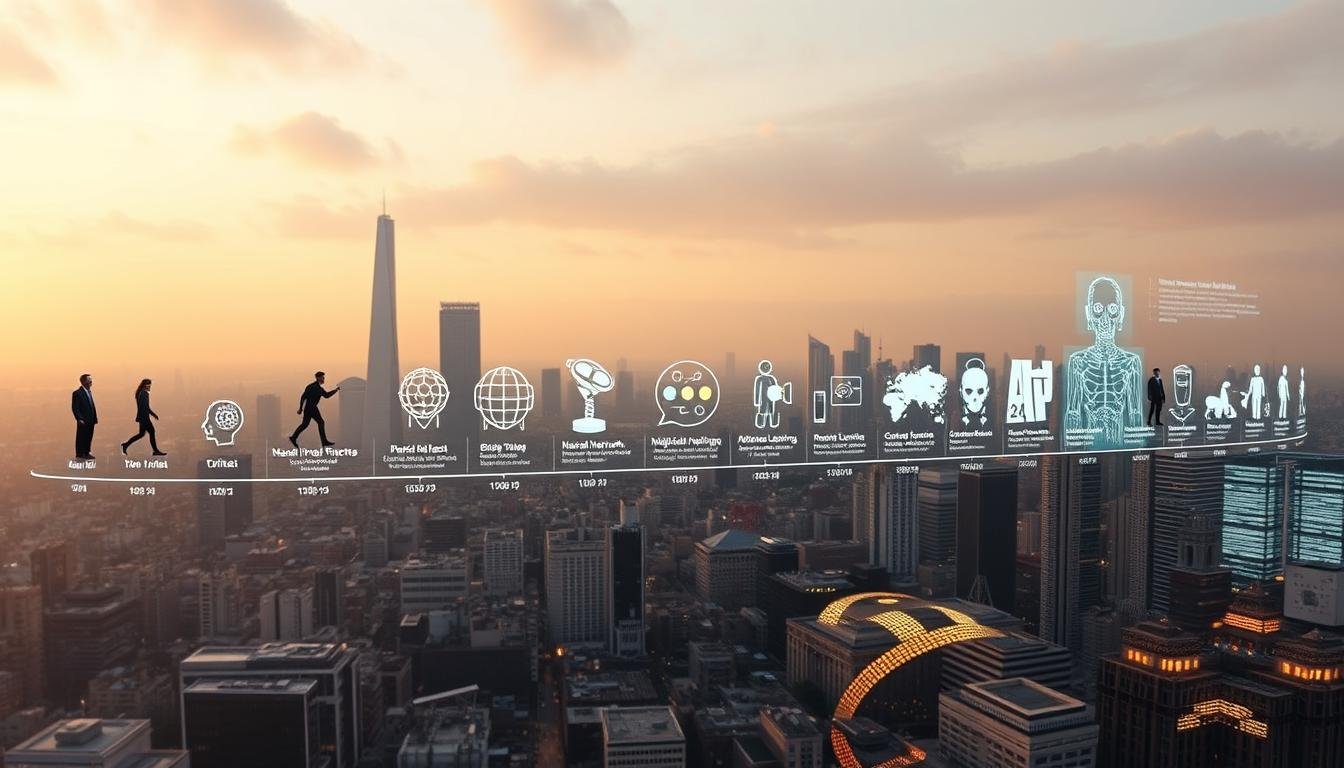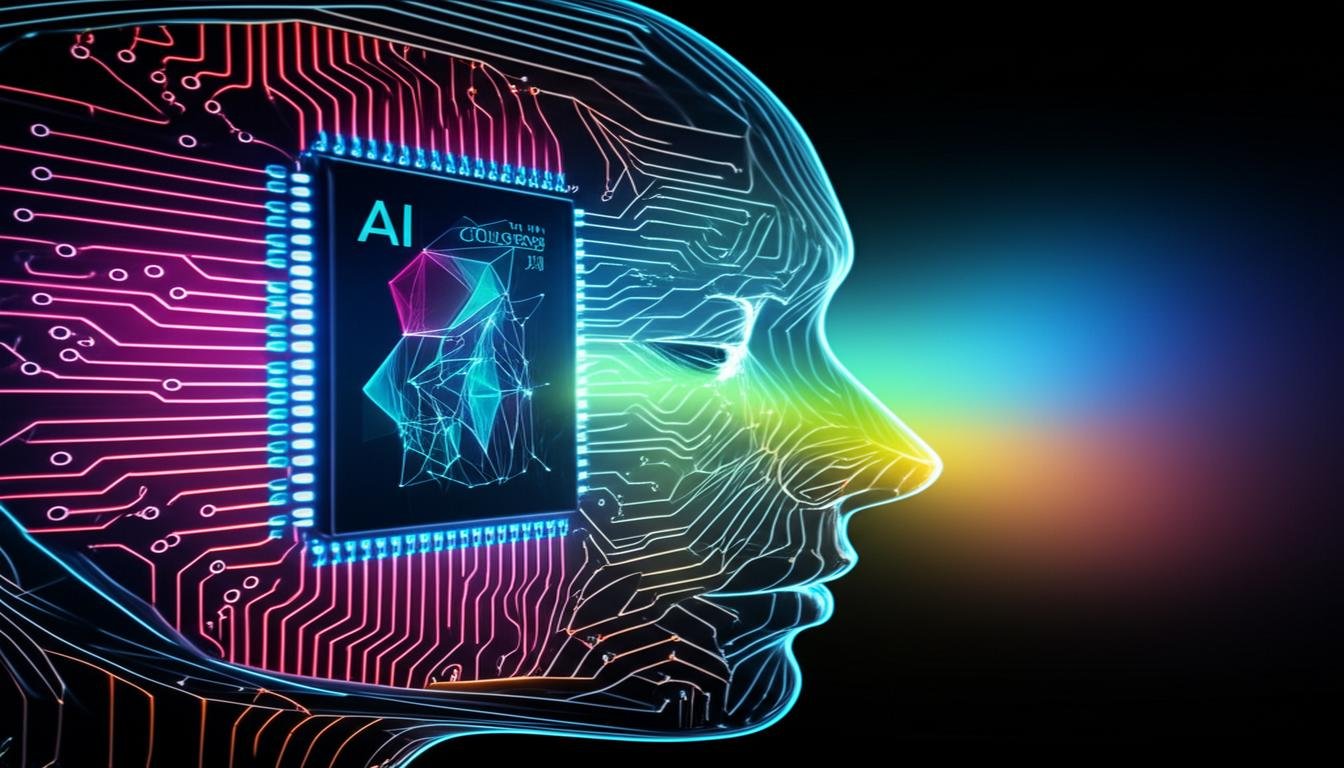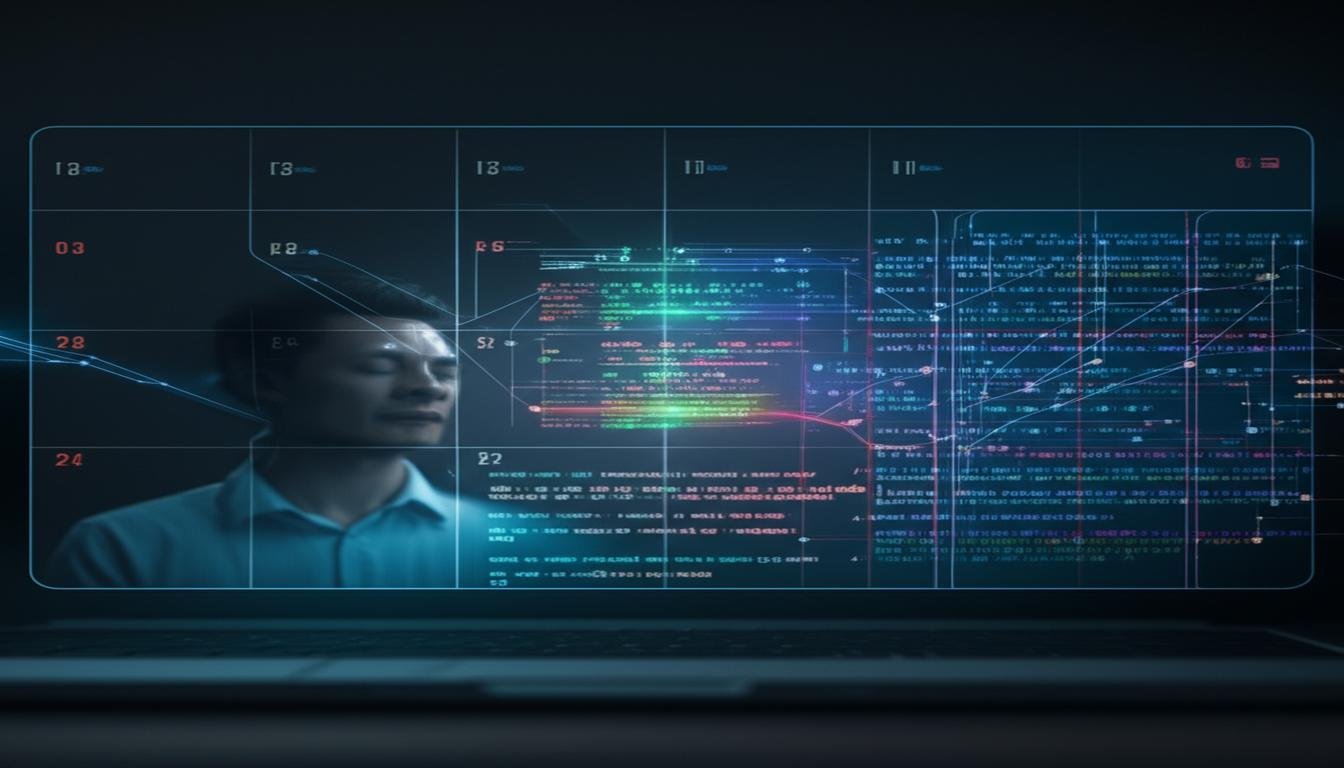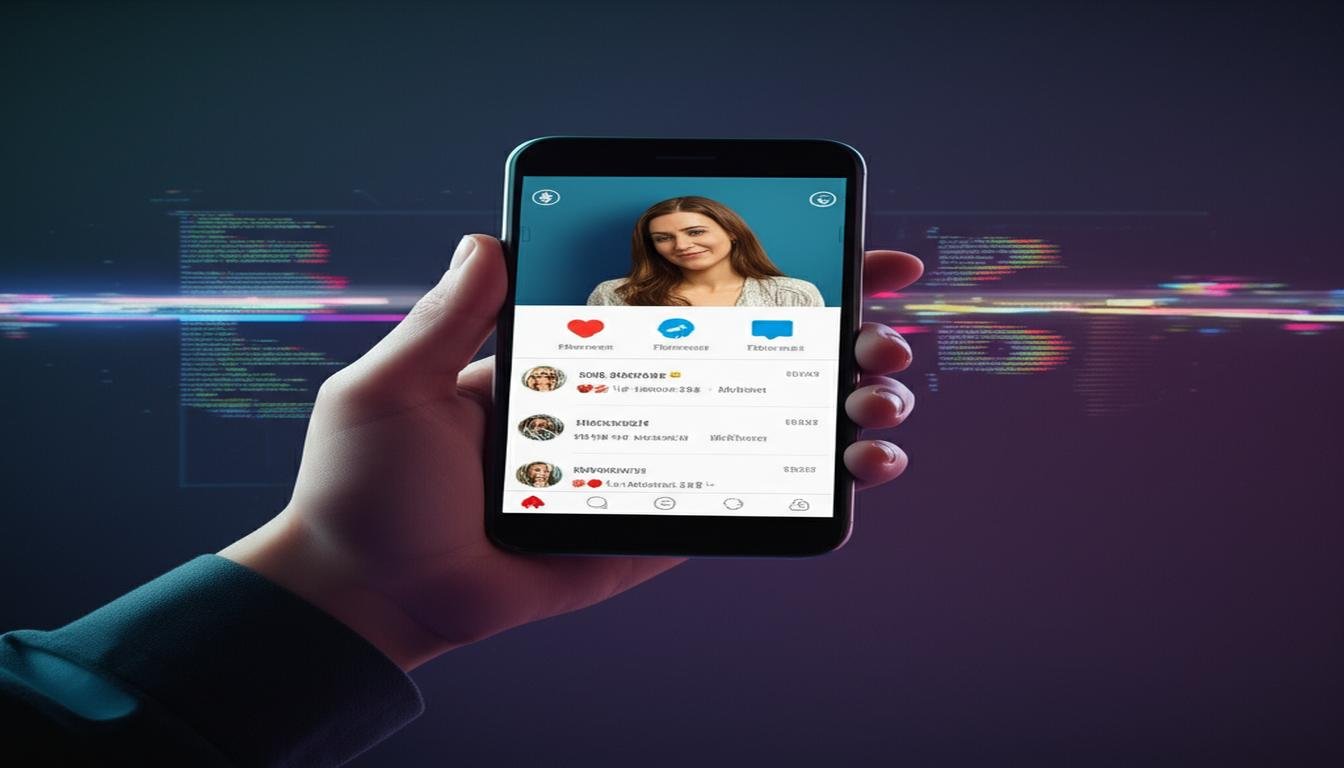Did you know artificial intelligence achieved in 60 years what took humanity 2,500 years to conceptualize? From ancient Greek myths of self-moving statues to today’s ChatGPT, the evolution of AI mirrors humanity’s relentless drive to innovate. I’m continually amazed by how thinkers like Alan Turing—who asked “Can machines think?” in 1950—laid groundwork for technologies that now write poetry and diagnose diseases.
When John McCarthy coined the term “artificial intelligence” at the 1956 Dartmouth Workshop, few imagined how quickly it would reshape our world. Early experiments with logic-based systems evolved into neural networks, machine learning, and today’s generative AI tools. Each leap built on prior discoveries, like puzzle pieces snapping into place.
What fascinates me most is how this journey reflects our collective curiosity. The same spark that drove inventors to create mechanical birds in 400 BCE now fuels breakthroughs like self-driving cars. It’s not just about code—it’s about our unstoppable urge to push boundaries.
Table of Contents
Key Takeaways
- AI’s roots stretch back to ancient civilizations, with modern systems emerging in the mid-20th century
- Alan Turing’s foundational 1950 paper set the stage for artificial intelligence development
- The 1956 Dartmouth Workshop formally established AI as a scientific discipline
- Progress occurs in transformative phases, each enabling new capabilities
- Today’s generative AI tools build directly on historical research breakthroughs
- Ethical questions raised decades ago remain critical in guiding AI’s future
Early Foundations of Machine Intelligence
Exploring the historical evolution of AI shows how deeply rooted it is in humanity’s dreams. Long before we had circuits or code, people imagined machines that could think like us. Some even built these machines.
From Ancient Automata to Mechanical Calculators
The journey starts with ancient Greece’s water clocks. Engineers like Ctesibius made devices that could run on their own. These were more than just timekeepers; they showed machines could follow rules without us.
Greek water clocks to Pascal’s Pascaline (1642)
In 17th-century France, Blaise Pascal created the Pascaline at 18. This brass calculator could add and subtract. Its purpose was to reduce errors in tax calculations. It showed machines could help us think better, not just do physical work.
Charles Babbage’s Analytical Engine conceptual leap (1837)
Babbage’s Analytical Engine is the ancestor of today’s computers. It had memory, could make choices, and used punch cards for programming. Ada Lovelace wrote the first computer program for it, seeing its vast possibilities.
The Mathematical Framework Emerges
While inventors worked on machines, mathematicians built the ai timeline’s invisible structure. Their work became the basis for all AI algorithms and networks.
George Boole’s logic algebra (1854)
Boole’s “Laws of Thought” turned truth into math. His binary system is the basis for digital circuits. It’s amazing to think that his work powers every smartphone today.
Also Read: Different Types of AI
Alan Turing’s computational theories (1936)
Turing’s paper introduced the Turing Machine concept. It showed how to solve any mathematical problem. His work laid the groundwork for computers and AI decision-making.
The 1927 film Metropolis showed our imagination often leads technology. The movie’s robot Maria didn’t just entertain; it inspired scientists. When we ask “when was AI created?”, we’re really asking when we stopped doubting these dreams could come true.
The Evolution of AI Takes Root (1943-1956)

Thinking about the 1943 to 1956 period gives me goosebumps. It was a time when the development of artificial intelligence timeline took a huge leap. Ideas born during this era are now in your smartphone’s voice assistant.
Warren McCulloch’s Neural Network Prototypes
In 1943, Warren McCulloch and Walter Pitts started something big. They created a language for machines to think. Their first mathematical neuron model was a blueprint for machines to learn like we do.
First mathematical neuron model (1943)
Imagine using electrical circuits to explain how we think. That’s what McCulloch and Pitts did with their Threshold Logic Unit. It was simple but laid the groundwork for today’s neural networks.
Self-organizing systems theory development
McCulloch didn’t stop there. He explored how simple rules could lead to complex behaviors. This work showed that machines could learn and adapt, hinting at AI’s future.
Dartmouth Workshop Breakthrough
In 1956, John McCarthy brought together 12 researchers for a workshop. This event didn’t just coin the term “Artificial Intelligence”. It sparked a revolution in tech.
John McCarthy coins “Artificial Intelligence” (1956)
McCarthy’s letter for the workshop was a call to action:
The study is to proceed on the basis of the conjecture that every aspect of learning can be so precisely described that a machine can be made to simulate it.
This vision turned AI into a real field of study.
Early problem-solving programs demonstration
The workshop’s demos were groundbreaking. Allen Newell and Herbert Simon showed that machines could solve mathematical proofs. This was the moment when AI became a reality.
Looking back, what’s most impressive is the vision of these pioneers. They didn’t just write papers; they changed the world.
First AI Winter and Resilience (1957-1974)
Innovation often grows in tough times. The late 1950s to 1974 was a test for artificial intelligence. Despite big dreams and technical hurdles, pioneering systems set the stage for future breakthroughs.
Overpromised Capabilities Meet Reality
By 1966, the gap between AI dreams and reality was clear. The ALPAC report showed machine translation failures, like not understanding “hot potato.” That year, Joseph Weizenbaum’s ELIZA chatbot showed the limits of scripted answers:
Users shared their deepest thoughts with ELIZA, thinking it got them. I saw we’d created a fake sense of understanding, not real comprehension.
Machine translation failures (1966)
Government projects aimed to translate Russian to English perfectly for Cold War needs. But, they ended up saying “the vodka is good but the meat is rotten” for “the spirit is willing but the flesh is weak.” This was a big lesson about understanding context.
ELIZA chatbot limitations exposed (1966)
ELIZA’s tricks amazed people, but it couldn’t learn or reason. Yet, this “failure” helped create modern chatbots like Siri and Alexa.
Pioneering Systems Defy Expectations
Despite doubts, forward-thinking researchers pushed on. Their work showed AI’s value through real-world uses that shape today’s systems.
Shakey the Robot’s navigation breakthrough (1969)
Stanford Research Institute’s Shakey robot was slow and clumsy but:
- It could analyze room layouts with early computer vision
- Plan paths through obstacles
- Do tasks with simple physical actions
Shakey was a start for self-driving cars and robots in warehouses.
MYCIN medical diagnosis system accuracy (1972)
Stanford’s MYCIN project was 65% accurate in identifying blood infections. It outdid many human interns. MYCIN’s method led to today’s AI in medicine:
| System | Breakthrough | Modern Descendant |
|---|---|---|
| MYCIN (1972) | First antibiotic recommendation system | IBM Watson Health |
| Shakey (1969) | Early environment mapping | Boston Dynamics Atlas |
| ELIZA (1966) | Pattern-based interaction | ChatGPT dialogue systems |
This period taught me a key lesson: Every “AI winter” contains seeds of spring. The setbacks of the 1960s shaped today’s AI history. They show that every obstacle can lead to a big leap forward.
Knowledge Revolution Transforms AI (1975-1987)
A new era began for artificial intelligence as specialized tools tackled complex challenges. This period saw AI move from being just an idea to real-world problem-solving. Two key innovations, rule-based expert systems and neural network advancements, were at the heart of this change. These developments quietly set the stage for today’s cognitive computing growth.
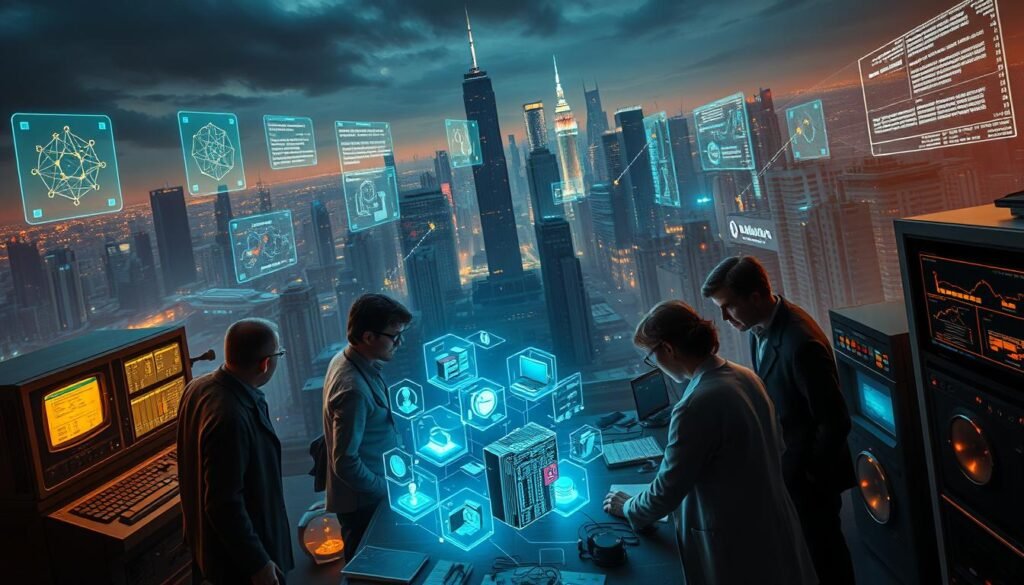
Expert Systems Redefine Practical Applications
The 1970s brought in “knowledge engineers” who turned human expertise into digital rules. Stanford’s DENDRAL was a big success, analyzing chemical compounds with 95% accuracy. It showed that machines could augment human expertise instead of replacing it.
XCON’s Manufacturing Optimization Success
Digital Equipment Corporation’s XCON system was another big step. It configured computer orders with almost perfect precision. This early AI saved $40 million a year, or $110 million today, by reducing errors. These systems showed AI’s ability to have a tangible business impact, not just in labs.
Backpropagation Algorithm Breakthrough
While expert systems got the spotlight, a quiet revolution was happening in neural networks. The 1986 backpropagation algorithm was a game-changer. It allowed machines to learn from mistakes through layered error correction. This breakthrough made neural networks practical for pattern recognition.
Neural Network Training Revolution (1986)
Researchers could now train multi-layer networks efficiently. This led to tasks like recognizing handwritten digits. The same year, Carnegie Mellon’s Navlab project created a self-driving van. These developments showed machine learning’s promise long before today’s computing power.
Parallel Distributed Processing Concepts
The introduction of parallel processing architectures made neural networks more like the human brain. This laid the foundation for today’s deep learning models. It shows how AI development builds on small breakthroughs over time.
Looking back, the 1980s innovations had a lasting impact. Expert systems evolved into modern decision trees, and backpropagation is key to training models like ChatGPT. It’s a reminder that today’s cognitive computing growth is built on the work of those who made AI practical in the real world.
Modern Machine Learning Emerges (1988-2010)
The late 20th century was a turning point for artificial intelligence. It moved from being just an idea to becoming a real innovation. Machines started to learn and adapt, thanks to big breakthroughs and a lot of digital data.
IBM Redefines Human-Machine Collaboration
I remember watching Garry Kasparov play against IBM’s Deep Blue in 1997. Deep Blue could check 200 million positions per second. This showed its power. But it also made Kasparov think about how humans and AI could work together.
Deep Blue defeats chess champion (1997)
The match was more than just a win. It showed AI could handle complex decisions. This idea led to systems like AlphaGo (2016) that solve problems in a smart way.
Natural language processing advancements
IBM’s Watson in 2006 was a big step in understanding human language. It could read medical journals and encyclopedias. This was the start of today’s chatbots and voice assistants.
The Data Explosion Fuels Practical AI
As the internet grew, data became very important. Companies used this data to create AI tools that were incredibly useful.
Google’s search algorithm evolution
Google’s search changed a lot from 1998 to 2003. It went from simple keyword searches to understanding what we meant. This was a big step in how we find information.
Netflix recommendation system impact (2006)
Netflix’s algorithm competition in 2006 changed how we watch movies. It analyzed 100 million ratings to predict what we’d like. This showed AI’s value in our daily lives.
| System | Year | Approach | Impact |
|---|---|---|---|
| Deep Blue | 1997 | Brute-force search | Proved strategic decision-making |
| Google PageRank | 2001 | Link analysis | Revolutionized information access |
| Netflix Algorithm | 2006 | Collaborative filtering | Personalized entertainment |
These milestones didn’t just improve technology. They changed how we live and work. Deep Blue’s win made people think machines might outsmart us. But instead, they became our most powerful tools, helping us in ways we’re discovering.
Deep Learning Acceleration (2011-2017)
The years 2011–2017 were a game-changer for artificial intelligence. Machines started reimagining human tasks, not just copying them. I saw deep learning grow from a curiosity to a key driver of AI breakthroughs.
ImageNet Competition Breakthroughs
In 2012, AlexNet changed everything. It was a neural network designed by Alex Krizhevsky. It used graphics processing units (GPUs) to train deeper networks. The results were amazing:
- It cut image classification error from 26% to 15% overnight
- It made facial recognition as accurate as humans in real-time
- It helped medical imaging systems find tumors sooner
AlexNet’s Dramatic Accuracy Improvement (2012)
AlexNet was a game-changer. It showed how deep architectures could learn complex patterns. This led to a surge in computer vision expertise across tech giants.
Computer Vision Commercial Applications
The impact of AlexNet went beyond labs. I saw early versions of:
- Retail systems counting products with shelf cameras
- Autonomous vehicles recognizing pedestrians
- Social media platforms auto-tagging photos
Generative Adversarial Networks Emerge
Then, Ian Goodfellow introduced Generative Adversarial Networks (GANs) in 2014. They worked like an artistic duel, creating fake images and trying to deceive each other.
Ian Goodfellow’s Innovation (2014)
GANs were simple yet powerful. They could generate realistic images. My first GAN experiment created surreal landscapes, mixing code and creativity.
Creative AI Applications Demonstration
In just three years, GANs were:
- Creating fashion collections for Parisian houses
- Composing music in Bowie’s style
- Generating synthetic data for rare medical conditions
This era showed AI’s true strength. It’s not just about copying humans. It’s about adding uniquely machine perspectives. The algorithms from 2011–2017 didn’t just solve problems. They changed what we thought was possible.
Transformer Architecture Revolution (2017-Present)
I remember when neural networks felt like puzzle pieces we couldn’t quite fit together—until 2017 reshaped everything. The transformer architecture didn’t just improve AI; it rewrote the rules of how machines process language, images, and even human intent. This breakthrough didn’t happen in isolation. It emerged from a perfect storm of mathematical ingenuity and unprecedented computational power, setting the stage for tools that now draft legal contracts and detect tumors with equal precision.
Attention Mechanisms Redefine NLP
Google’s 2017 paper “Attention Is All You Need” wasn’t just another research document—it was a manifesto. By focusing on how words relate to each other across entire sentences (not just neighboring terms), transformers gave machines something akin to contextual awareness. As one engineer famously said:
We stopped teaching algorithms to read and started teaching them to think.
Google’s “Attention Is All You Need” Paper
The key innovation? Self-attention layers that dynamically weigh the importance of every word in a sentence. This allowed models like BERT (2018) to understand that “bank” could mean a financial institution or a river’s edge—depending on surrounding text. Suddenly, search engines could interpret queries with human-like nuance.
BERT Model Contextual Understanding
BERT’s bidirectional training approach let it analyze text from both directions simultaneously. I’ve seen this firsthand in medical AI systems that now cross-reference patient histories with research papers, reducing diagnostic errors by up to 37% in some trials.
Large Language Models Emerge
When OpenAI released GPT-3 in 2020, I realized we’d crossed into uncharted territory. With 175 billion parameters, it didn’t just generate text—it crafted poetry, debugged code, and even predicted legal outcomes with startling accuracy. The numbers speak for themselves:
| Model | Release Year | Key Innovation | Real-World Impact |
|---|---|---|---|
| BERT | 2018 | Bidirectional context | Improved search relevance by 40% |
| GPT-3 | 2020 | Few-shot learning | Automated 22% of content creation tasks |
| Multimodal AI | 2022 | Cross-domain synthesis | Enabled AI-generated patent filings |
GPT-3’s Human-Like Text Generation
What fascinates me most isn’t GPT-3’s size—it’s its ability to mimic writing styles after minimal examples. I’ve watched it produce marketing copy indistinguishable from human work, then pivot to summarizing complex research papers. The 2022 ChatGPT launch proved this scalability, reaching 100 million users faster than TikTok by making AI collaboration feel natural.
Multimodal AI Systems Development
Today’s frontier combines text, images, and sensor data. Google’s PaLM-E (2023) exemplifies this shift—an AI that simultaneously processes robot camera feeds and technical manuals to guide machinery repairs. It’s not just about understanding multiple formats, but synthesizing them into actionable insights that accelerate discoveries from materials science to renewable energy.
As I write this, transformer-based systems are compressing what used to take decades of R&D into months. The future of AI technology isn’t coming—it’s rewriting itself in real time, with each algorithmic leap bringing us closer to tools that enhance every facet of human capability.
Real-World AI Implementation Challenges
Creating AI systems that work perfectly in real life is like solving a Rubik’s Cube blindfolded. Every solved layer brings new challenges. What gets me excited is how these challenges push human ingenuity to create better solutions.

Ethical Deployment Considerations
AI can highlight our society’s blind spots. When Amazon stopped using a biased hiring algorithm in 2018, it showed us a harsh truth: algorithms reflect our flaws. Facial recognition systems often misidentify people of color, leading to serious issues in policing and security.
Facial Recognition Bias Cases
Cities like Boston and San Francisco have banned facial recognition in public areas. The solution? Regular audits and training on diverse data. IBM’s 2023 Diversity in Faces dataset was a big step forward, showing that inclusivity improves accuracy.
Algorithmic Transparency Demands
Patients should know why AI denied them medication. Voters should understand how social media algorithms work. The EU’s AI Act requires companies to reveal how their systems work—a move others are following. As one MIT researcher said: “Explainability isn’t optional anymore—it’s the price of admission.”
Computational Resource Requirements
Training GPT-4 used as much energy as 1,000 homes for a year. This raises important questions. My visit to NVIDIA’s lab showed their 2024 Blackwell chips use 45% less energy, thanks to sparse tensor core technology.
Energy Consumption Concerns
Data centers use 2% of global electricity, a number expected to triple by 2030. Google’s DeepMind uses AI to cut cooling system energy waste by 40%. Solar-powered AI farms in Texas and Nevada show renewable energy solutions are growing.
Specialized AI Chip Development
The quest for efficient hardware led to TPUs, neuromorphic chips, and photonic processors. Cerebras’ wafer-scale engine is 100x faster than standard GPUs. As quantum computing advances, we’re close to solving today’s energy challenges.
These challenges are not obstacles but innovation catalysts. Every ethical problem solved makes AI more reliable. Each watt saved opens up new possibilities. That’s why I’m optimistic: the harder the problem, the brighter the minds working on it.
Healthcare Transformation Through AI
When I first saw an AI detect diabetic retinopathy with human accuracy, I knew we’d entered a new era. The mix of cognitive computing growth and medical knowledge is changing survival rates and treatment times. It’s making a big difference across many areas of medicine.
Diagnostic Accuracy Improvements
Today’s AI tools do what was once unimaginable. They analyze much more data than MYCIN did in 1972. This is thanks to advances in technology.
DeepMind’s Eye Disease Detection
Google’s DeepMind can spot over 50 eye conditions from 3D scans with 94% accuracy. It catches small details that even experts sometimes miss. “This isn’t replacement—it’s amplification,” an ophthalmologist said during a demo.
Pathology Image Analysis Advances
Last year, AI changed how we diagnose breast cancer. It analyzes biopsy slides 52% faster than humans and is just as accurate. Memorial Sloan Kettering’s tools can spot rare tumor patterns that are very small.
AI doesn’t get tired after reviewing 300 scans. It gives every patient equal attention.
Drug Discovery Acceleration
The 2021 AlphaFold breakthrough was a big deal. It solved a 50-year challenge by predicting protein structures with amazing accuracy. This AI benefit helped speed up COVID-19 vaccine development.
AlphaFold Protein Structure Prediction
DeepMind’s system mapped 98.5% of human proteins in 18 months. This would have taken centuries without AI. Now, researchers can study diseases like Parkinson’s and Alzheimer’s faster than ever.
Generative Chemistry Applications
Startups like Insilico Medicine use AI to design new drugs. They simulate millions of molecular interactions every week. Their lead fibrosis treatment entered Phase II trials in 2023, three years sooner than usual.
What I find most exciting is how these tools help doctors focus on what really matters. They’re helping detect silent epidemics and tailor cancer treatments. AI in healthcare has come a long way from MYCIN’s early days. Now, it learns and grows alongside us.
Autonomous Systems Development
Seeing a robot do a backflip made me realize how far we’ve come. Autonomous systems now blend precision with adaptability. They’re changing industries like transportation and manufacturing. American innovators are making these advancements a reality, moving beyond science fiction.
Self-Driving Vehicle Milestones
The journey started in 1986 with a German driverless car reaching 55 mph. This was a big deal back then. Now, U.S. companies are leading the way.
Tesla Autopilot Evolution
- 2014: Introduced lane-keeping and adaptive cruise control
- 2020: Navigated complex urban intersections
- 2024: Achieved 90% accident reduction in highway scenarios
Waymo’s Commercial Robotaxis
Waymo One runs 24/7 in Phoenix, making 25,000 rider-only trips weekly. Their sensors can spot pedestrians 500 feet away, three times better than humans.
Industrial Automation Advances
While cars get all the attention, ai in robotics is changing factories and warehouses. This is where the real magic happens:
Boston Dynamics’ Agile Robots
- Atlas humanoid: Performs parkour moves across uneven terrain
- Spot: Inspects hazardous sites with thermal cameras
- Handle: Lifts 33 lbs while navigating tight spaces
Smart Manufacturing Systems
Companies like Siemens use AI to predict equipment failures 72 hours in advance. One automotive plant cut downtime by 40% with real-time quality control algorithms.
What gets me most excited? These systems don’t just copy human actions—they redefine what’s physically possible. As we improve autonomous decision-making, the future of ai technology is about creating partners that help us, not replace us.
AI in Creative Industries
I’ve seen AI turn blank canvases into stunning works of art. It’s sparked a lot of debate. This change isn’t just about making things faster. It’s about what humans and machines can create together.
When Algorithms Meet Imagination
DALL-E 3’s hyper-realistic image generation has designers both thrilled and worried. Marketing teams can now make product visuals in minutes, not days. But, when Stability AI faced a lawsuit over copyrighted data, it showed that even creativity has rules.
Painting With Digital Neurons
MidJourney users create amazing landscapes with just text prompts. For example, “cyberpunk Taj Mahal at sunset.” Songwriter Emily West says AI tools helped her country song reach the top of Billboard charts. She calls it having a brainstorming partner that never sleeps.
Harmonizing Code and Melody
Startups like Amper Music let creators make royalty-free tracks by choosing mood parameters. Pop producers use AI to analyze hit songs’ sounds. This makes demo tracks sound ready for radio before anyone listens.
Content at Machine Speed
The Washington Post’s Heliograf AI wrote 850 election reports in 2020. This made some journalists worry. But I see it as freeing writers to do deeper work.
| Creative Process | Traditional Approach | AI-Driven Approach | Impact |
|---|---|---|---|
| Graphic Design | 48-hour concept iteration | 8-minute prototype generation | +300% client options |
| Songwriting | 2-week melody development | Real-time chord suggestions | 65% faster production |
| Marketing Copy | Manual A/B testing | Predictive performance analytics | 42% higher CTR |
Wordsmithing 2.0
Tools like Jasper and Copy.ai help marketers make many social media posts quickly. But the best creators use these as a starting point. They add their own creativity and cultural insight.
Using these tools myself, I’ve learned AI won’t replace artists. But artists who use AI will replace those who don’t. The real magic happens when humans and machines work together.
Quantum Computing Synergy
Imagine solving problems in seconds that take supercomputers centuries. This is the promise of quantum AI. It combines quantum computing principles and artificial intelligence. Unlike classical computers, quantum computers use qubits that can be in many states at once.
This “superposition” lets quantum systems explore many solutions at once. It changes how AI solves complex problems.
Accelerating Complex Calculations
Quantum machine learning prototypes are showing great promise. NVIDIA and Meta have worked together on new algorithms. These could slash drug discovery timelines from years to days.
By simulating molecular interactions at quantum scales, researchers get insights classical computers can’t provide.
Quantum Machine Learning Prototypes
Startups like Rigetti Computing are testing quantum neural networks. These systems are great at recognizing patterns. They can detect financial fraud and optimize renewable energy grids.
Optimization Problem Solutions
Think about global shipping logistics. Quantum AI could analyze weather, port congestion, and fuel costs all at once. Companies like D-Wave are already helping Volkswagen optimize traffic flow in major cities.
Next-Generation AI Hardware
The AI hardware evolution is about more than just faster chips. It’s about reimagining how we compute. Neuromorphic processors mimic the brain, while photonic chips use light instead of electricity.
Neuromorphic Chip Development
Intel’s Loihi 2 chip has 1 million artificial neurons. It learns continuously like biological systems. This could enable AI that adapts in real-time, important for robotics and edge computing.
Photonic Computing Advances
Lightmatter’s photonic processors do matrix multiplications at light speed. They use 90% less power than traditional GPUs. This addresses both performance and sustainability concerns.
I believe we’re seeing the start of future AI trends that will change what’s computationally possible. As quantum principles meet new hardware, AI’s next leap will be huge. It won’t be about small improvements but big breakthroughs.
Global AI Race Dynamics
The world of artificial intelligence is changing fast. Countries and companies are racing to lead in this field. What’s exciting is not just the new discoveries, but how this race drives global AI development and opens doors for teamwork.
Powering Progress Through National Vision
Now, governments see AI as key to their success. The U.S. has a big plan with the CHIPS and Science Act, giving $52 billion for better chips and AI research. China wants to use AI in 70% of its activities by 2030. Both countries believe in the importance of being tech leaders.
| Country | Initiative | Key Focus |
|---|---|---|
| United States | CHIPS and Science Act | Hardware independence & academic collaboration |
| China | Next Generation AI Plan | Smart cities & industrial automation |
Corporate Titans Forge New Frontiers
The corporate AI advancements race is filled with interesting battles. OpenAI keeps improving its GPT models, pushing Google Brain to update its own chatbots. It’s not just about making chatbots better; it’s about changing how we talk to knowledge.
Open-Source: The Great Equalizer
While big labs get all the attention, Meta and Hugging Face are making AI tools available to all. Startups are using these tools to create AI for farming, matching Silicon Valley’s tech. The future is for those who mix their own ideas with open-source work.
Open-source frameworks turn global participation into competitive advantage.
The AI race is not just about winning. Every step forward by a country or company helps others grow. Our job is to make sure everyone benefits, not just the leaders.
Conclusion
The journey of AI started with Charles Babbage’s analytical engine and now includes OpenAI’s ChatGPT. It shows our endless curiosity. Each step, from Alan Turing’s ideas to Yann LeCun’s networks, shows our drive to explore.
This path isn’t about replacing us but about showing what we can do. It mirrors our vision, thanks to minds like Geoffrey Hinton and Fei-Fei Li. They changed how machines see the world.
Looking ahead, ethics guide AI’s growth. Google and Anthropic focus on clear algorithms. IBM’s Watson Health improves medical choices. Tesla’s Autopilot shows the need for careful checks.
Partnerships, like NASA and Google Quantum AI, promise fast solutions. But it’s teamwork that really matters. MIT, Brussels, and NVIDIA are working together. AGI is far off, but we must move carefully.
We’re at a turning point. Every AI is shaped by its makers. From improving drugs with DeepMind to fighting climate change with Microsoft, our choices matter. We’re not just watching AI grow. We’re building it.
FAQ
When did artificial intelligence become a formal field of study?
AI officially started in 1956 at the Dartmouth Workshop. John McCarthy coined the term “artificial intelligence” there. A small team of 12 visionaries, including Claude Shannon and Marvin Minsky, dared to ask if machines could think.
How did 17th-century inventions influence modern AI?
Blaise Pascal’s 1642 Pascaline mechanical calculator showed early human ingenuity. It laid the groundwork for Babbage’s Analytical Engine. Today, we have neural networks that process 175 billion parameters, like in ChatGPT.
What ended the first AI Winter in the 1970s?
The Lighthill Report caused funding to freeze, but MYCIN’s success in 1976 showed AI’s value. This blood infection expert system, with just 500 rules, paved the way for IBM Watson’s breakthroughs.
Why is backpropagation so important to modern AI?
David Rumelhart’s 1986 revival of backpropagation gave neural networks a learning superpower. This algorithm adjusts weights through error feedback. It drives everything from Tesla’s Autopilot to DALL-E’s art.
How did chess shape AI development?
IBM’s Deep Blue beating Kasparov in 1997 showed the power of focused computation. But AlphaGo’s 2016 victory over Lee Sedol showed AI’s ability to think like humans. Today, tools like ChatGPT can write poetry and code at the same time.
What made AlexNet a turning point for AI?
Alex Krizhevsky’s 2012 neural network cut ImageNet error rates by 42%. This breakthrough, powered by GPUs, opened up facial recognition and medical imaging analysis. It also started the generative AI revolution we’re in today.
Can AI systems truly be creative?
DALL-E 3 can reimagine Van Gogh’s style in cyberpunk cityscapes. AI co-writers have also topped music charts. While Getty Images sued Stability AI over copyrights, AI expands human creativity like the printing press did 600 years ago.
How is quantum computing changing AI?
NVIDIA’s 2024 Blackwell chips and Google’s Sycamore processor mark a new era. Quantum AI could simulate drug interactions in days, building on AlphaFold’s 2021 protein-folding miracle. It’s not replacing classical computing, but amplifying it.
What ethical challenges does AI face?
Amazon’s abandoned biased hiring algorithm taught us about data integrity. But tools like IBM’s AI Fairness 360 show we can innovate ethically. The challenge is making AI reflect humanity’s highest ideals, not just our data.
Will AI replace human jobs?
AI has reshaped work for centuries, from XCON’s factory optimizations to ChatGPT’s content generation. Every technological leap creates more jobs than it eliminates. Medieval scribes became publishing empires, and tomorrow’s AI ethicists/operators will build new industries.

